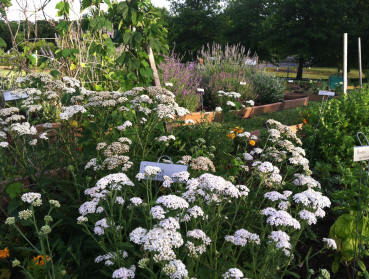 (7/14) Spring is here; it’s time to plant in the trial Garden!!! In 2017 I am taking over from Jen who planted the Beer Garden last year. All last year, I assisted in the weeding of the garden which was very difficult, because I wasn't sure what was a weed or a plant. Hopefully this year I
will have a fresh start, making a list of what I have planted.
(7/14) Spring is here; it’s time to plant in the trial Garden!!! In 2017 I am taking over from Jen who planted the Beer Garden last year. All last year, I assisted in the weeding of the garden which was very difficult, because I wasn't sure what was a weed or a plant. Hopefully this year I
will have a fresh start, making a list of what I have planted.
Presently, lemon balm, yarrow, and oats survived from last year. This year, I have planted wheat, barley, and more oats for the grains as well as herbs and spices for flavoring. I have also added marigold for color and to act as an insect repellent.
Many brewers make beer from any malted grain, so the choice is up to the grower and the flavor they are after. However, a beer garden won't be complete without hops, Humulus lupulus, a vine with distinctive cone shaped flowers that are harvested and dried. For thousands of years people made perfectly wonderful beer out of whatever was available,
but in more recent times the hops were added to give the bitterness to the drink.
In addition to the hops, here are some other plants you will see growing in the 2017 Beer Garden:
Wheat - Triticum aestivum is widely gown around the world as a staple source of diet for a variety of reasons. Many folks grow wheat for making beer.
Oats - Avena sativa is so easy to grow, in less than a month they have reached 18" in the trial garden. According to the Whole Grains Council "oats almost never have their bran and germ removed in processing" so it is a very healthy grain.
Barley- Hordeum vulgare is one of the four major grains grown in the world from the grass family. They prefer temperate climate. It ferments well not only for beer but for other malted distilled drinks.
Cilantro (original name Coriander) - Coriandrum sativum loves shaded areas. It goes to seed early in the growing season and is used as a spicy flavor in homebrews. If the leaves are harvested, it is called cilantro, but if the seeds are harvested it is called coriander. Cilantro grows 1 to 2 feet tall and has finely cut leaves that resemble flat
leaf parsley. Best cut before they go to seed and take over the garden.
Lemon balm - Melissa officinalis, a member of the mint family, is considered a calming herb. It was used as far back as the Middle Ages to reduce stress and anxiety, promote sleep, improve appetite, and ease pain and discomfort from indigestion. Today, lemon balm is often combined with other calming, soothing herbs, such as valerian, chamomile, and
hops, to promote relaxation.
Yarrow - Achillea millefolim is a fernlike herb that spreads quickly in the garden, but taking the time to tend the unruly plant pays off. Yarrow flourishes in bright sunlight, and is drought tolerant. Yarrow grows to 3 feet high, and all parts of the plant can be used in the brewing process to add bitterness and a pungent odor. Yarrow was commonly
used in the brewing process before hops became the bittering agent of choice.
Rosemary - Rosmarinus officinalis thrives in bright sunlight. In this region, the plant should be brought indoors during the winter. This plant can be added as a substitute for hops in home-brewing.
Lavender - Lavandula angustifolia with its distinctive scent has a rosemary-like aroma with sweet and flowery undertones. These pungent stems can add both flavor and fragrance to your homebrews. The head of the plant, when in bloom, can also be used in the brewing process. Lavender does not typically exceed 3 feet in height, and prefers bright
sunlight. Although categorized as a perennial, some types of lavender will grow for only two to three years.
Marigold - Calendula officinalis is an annual plant that blooms all summer and late into the autumn. It is a very hardy and drought resistant plant and plays an important role in the garden. Its blossoms come in varieties of shades from bright orange and yellow to orangery red. Together with the green feathery leaves it has a pungent smell that
drives away many harmful insects from your plants. In the trial garden this season, I grew the Marigold from seeds and then transferred them between the rows of the plants. With very little watering, they are thriving quite well in the trial garden. Come and see for yourself!
There are many more herbs and other plants to grow in your beer garden, but for the purpose of this trial garden I have chosen to grow and study these plants.
Read more articles by Marann Jones